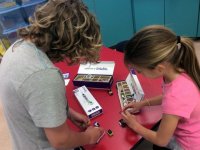Turn Traditional Units of Study Into Deeper Learning Experiences
A third grade class asked why their state, Rhode Island, had no official state insect when 46 other states did. Read what happened next.
Your content has been saved!
Go to My Saved Content.Visit elementary classrooms across the country and you're likely to find plenty of students studying state geography and state symbols. But how often does the learning stop with memorization, recall, or perhaps a short-term activity? How many students get a chance to think critically and apply their understanding? Years from now, what will stick with them from their state studies?
To see how a traditional unit can be remodeled into a more authentic project that leads to deeper learning, consider how third grade students at St. Michael's Country Day School in Newport, Rhode Island, spent this school year.
During a lesson on state symbols, students raised an interesting question: Why doesn't Rhode Island have an official state insect? After all, 46 other states do.
Teachers Lorie Loughborough and Linda Spinney could have shrugged off that question and continued with their lesson plans. Instead, the question became the springboard for in-depth inquiry and a student-led campaign that took them all the way to the statehouse.
Here's what Rhode Island State Senator Susan Sosnowski had to say in May when she introduced a bill to the Senate, designating the American burying beetle as Rhode Island's official state insect:
I'm willing to bet that those real-life lessons -- along with an understanding of ecosystems, environmental science, and more -- will stick with students long after their elementary years are over.
Let's take a closer look at how a traditional unit can be remodeled into more authentic, and memorable, project-based learning.
A Project Takes Shape
I had a chance to hear from St. Michael's students (and their teachers) earlier this year, before they succeeded in getting their bill passed unanimously by the state Senate. Students were eager to explain why they had taken up the cause of the American burying beetle.
Once they decided to lobby for a state insect as a class project, they had to make a choice. Students investigated various options and thought critically about which insect would make a good symbol.
Other states have already designated the monarch butterfly, European honeybee, and ladybug. (Back in 1974, a second grade class from Lulu M. Ross Elementary School in Milford, Delaware, convinced their state legislature to have the ladybug designated as their state insect.) So St. Michael's students took their investigation deeper, asking: Is there an insect that's unique or special to Rhode Island?
When a conservationist from Rogers Williams Park Zoo introduced students to the American burying beetle, they found their candidate. Students learned that the beetle is a "natural recycler," enriching soil by feeding on dead animals. Once common across the Eastern U.S., the American burying beetle has been on the endangered species list since 1989. Block Island, a tourist destination and nature preserve off Rhode Island's coast, is one of its last remaining habitats.
Students next used their communication skills to advocate for the beetle. That led to letter-writing campaigns to local newspapers and interviews with TV stations. Students supported their arguments with carefully researched scientific information. Those letters and interviews helped get them ready to testify before the state senate committee.
Throughout the project, teachers made key decisions that took learning to a deeper level, including:
- Giving students more voice and choice in their learning
- Connecting learning goals (such as understanding habitats and food chains) to a real-life issue (protecting an endangered species)
- In-depth inquiry (starting with a student-generated question)
- Producing an authentic product (advocating for legislation)
- Learning from expert sources (such as the zoo's conservation scientist)
- Going public to take learning into the world beyond the classroom
Did these teachers have every lesson planned out in advance? Far from it, they'll readily admit. But as the project unfolded, they took advantage of each opportunity to encourage in-depth inquiry and respond to students' questions with just-in-time teaching.
Hands-On Remodeling
Are you interested in remodeling a traditional unit into a more student-centered, inquiry-driven project?
That's the focus of "Hands-On Project Remodel: Rethink PBL to Take Learning Deeper," an interactive ISTE 2015 session that I'll be co-facilitating later this month with Mike Gwaltney (@mikegwaltney), history teacher and PBL veteran from Oregon Episcopal School. (Read an earlier post about an inspiring, real-world project from Gwaltney's government class, How PBL Creates Engaged Citizens.
If you're planning to attend ISTE 2015, please join us on Tuesday, June 30, from 12:30-1:30 p.m. EDT at the Philadelphia Convention Center. Bring a traditional unit idea or lesson plan that you want to remodel, and be ready to roll up your sleeves and start remodeling.
Meanwhile, please use the comments to share your thoughts and suggestions about project remodeling.
